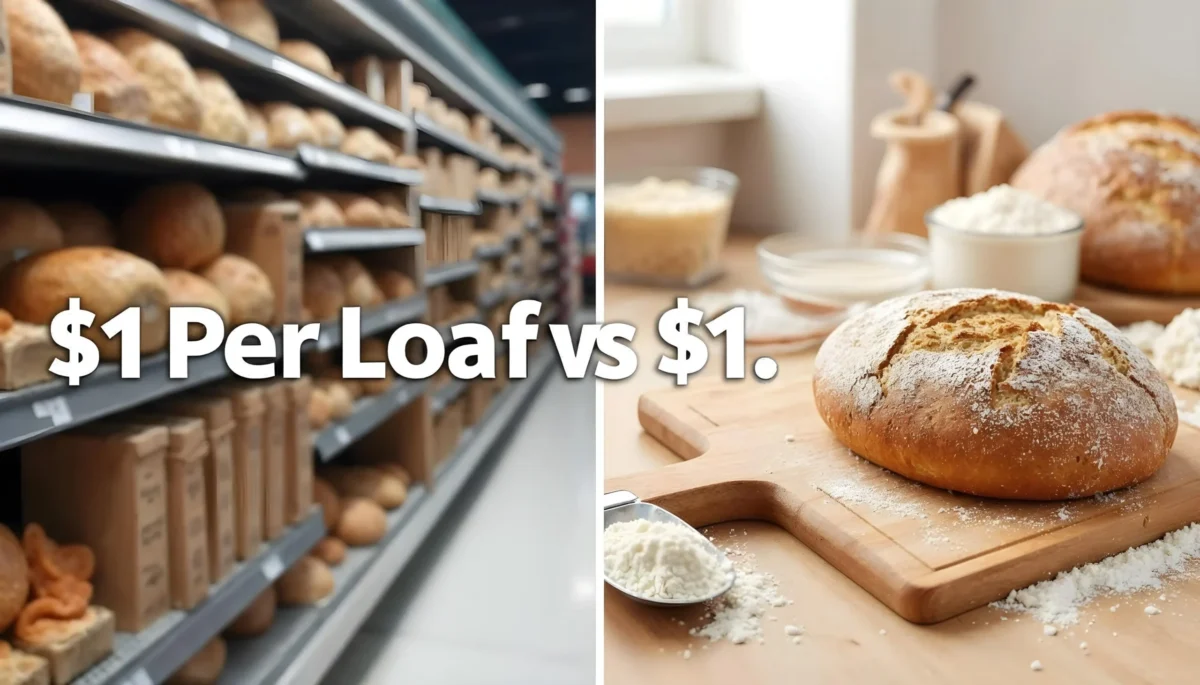Alright, let’s get real for a second. If you’ve ever found yourself standing in the bread aisle at your local grocery store wondering, “Should I just bake this myself?”—you’re not alone. With rising food prices and everyone looking to save a buck, it’s a fair question. So, what’s the deal? Is it cheaper to buy bread or make it in a bread machine? Let’s break it down.
Table of Contents
Table of Contents
Cost Comparison of Store-Bought Bread vs. Homemade Bread
Price of Store-Bought Bread
When you grab a loaf of bread off the shelf, you’re paying for more than just flour and water. The cost of store-bought bread typically includes:
Want to save this recipe?
Enter your email to get it sent to your inbox! Plus you'll get new recipes from us every week.
- Ingredients
- Packaging
- Transportation
- Labor
- Branding
For your standard white or whole-wheat loaf, prices can range from $2 to $5. Artisan or specialty breads, like sourdough or gluten-free options, can climb as high as $8 or more per loaf.
But wait—those budget loaves are tempting, right? They’re cheap, but they often come with a longer list of additives and preservatives. If quality and taste matter to you, you’re probably already leaning toward the pricier end of the spectrum.
Cost of Making Bread in a Bread Machine
Now, let’s look at homemade bread using a bread machine. Here’s a basic breakdown of what it’ll cost you to make a single loaf:
- Flour: About $0.50–$1 per loaf (depending on the type).
- Yeast: Roughly $0.10–$0.20 per loaf (buying in bulk saves money).
- Sugar: Pennies—literally, around $0.05 per loaf.
- Salt: Another $0.05.
- Milk, Butter, or Oil: Around $0.30–$0.50 depending on the recipe.
In total, the cost of making a loaf of bread at home averages $0.80 to $1.50.
Add in the upfront cost of a bread machine—typically $50 to $300—and the numbers might look intimidating at first. However, if you’re regularly baking, the machine pays for itself over time.
Factors to Consider Beyond Cost

Homemade bread starts with just a few simple ingredients.
Convenience and Time
Buying bread is simple: grab it, toss it in your cart, done. Making bread at home with a machine requires a bit of prep—measuring ingredients, loading the machine, and waiting 3–4 hours for the loaf to bake.
But here’s the thing: a bread machine does most of the work for you. Once you’ve set it up, you can go about your day while it kneads, rises, and bakes.
Taste and Quality
Let’s be honest—nothing beats the taste of fresh-baked bread. Store-bought bread often has that “processed” flavor, while homemade bread is softer, fresher, and completely customizable. Want less sugar? Add less. Love rosemary? Toss some in.
Nutrition
Homemade bread is a win if you’re watching what you eat. You can skip the preservatives, control the salt content, and even make whole-grain or gluten-free loaves with ease. Plus, there’s something satisfying about knowing exactly what’s in your food.
Does a Bread Machine Save You Money?

Your bread machine does all the hard work while you enjoy the results.
Let’s get into the nitty-gritty of whether a bread machine really saves you money. Spoiler alert: it usually does—but let’s break it down with more detail.
Here’s the big picture: if you’re baking bread regularly—let’s say 2–3 loaves a week—you’re almost guaranteed to save money in the long run. Why? Because the cost of the ingredients for homemade bread is significantly lower than the price of store-bought loaves, especially if you prefer higher-quality or specialty bread.
The Math of Homemade Bread
Let’s start with some quick math for a typical year:
- Baking 2 loaves a week for a year:
Using basic ingredients like flour, yeast, sugar, and salt, each loaf costs you about $1. So, that’s ~$104 annually (ingredients only). - Buying 2 loaves a week for a year:
Depending on the type of bread you buy, prices range from $2 for basic white bread to $5 (or more) for specialty loaves. That adds up to $208 (for $2 loaves) or $520 (for $5 loaves) annually.
Even if you factor in the upfront cost of a bread machine—typically $50 to $300—you’ll break even in less than a year if you’re baking consistently. For example, if you invest in a mid-range $100 bread machine, the savings kick in after about 50–100 loaves. After that, every loaf you bake is pure savings.
Electricity Costs for a Bread Machine
Worried about your energy bill? Don’t be. Bread machines are surprisingly efficient. Most models use about 0.3–0.5 kWh of electricity per loaf, which translates to roughly $0.05–$0.10 per loaf based on average electricity rates. Even if you bake 100 loaves a year, the electricity cost adds only a few dollars to your total.
The Cost of Extras
Now, let’s talk about those “extras.” If you love adding ingredients like seeds, herbs, or nuts to your bread, the cost per loaf will go up slightly. But these extras are still far cheaper than buying pre-made specialty loaves, and you have the freedom to add exactly what you like. Want sesame-crusted sourdough? Go for it. Prefer cinnamon raisin bread? Done.
Savings Over Time
If you stick with homemade bread, the savings grow year after year. Here’s an example of how the numbers stack up over five years:
- Buying bread:
At $2 per loaf, you’d spend $1,040 over five years. For $5 loaves, you’d spend $2,600. - Baking bread:
Even with premium ingredients and energy costs, you’ll spend around $520 over five years (including the one-time bread machine cost).
That’s a potential savings of $500 to $2,080 over five years—just by baking your own bread!
What About Occasional Bakers?
If you don’t bake often, a bread machine might not save you much money. For someone who bakes, say, once a month, the upfront cost of the machine would take years to recover. In this case, it might be smarter to stick with store-bought bread or bake by hand occasionally without a machine.
Long-Term Benefits of a Bread Machine
Beyond the dollar signs, there are some long-term perks of owning a bread machine:
- Less waste: No more half-eaten loaves going stale on the counter. You bake only what you need.
- Customization: Make bread exactly the way you want it, from texture to flavor to nutrition.
- Convenience: The “set-it-and-forget-it” nature of a bread machine saves time compared to traditional hand-baking methods.
In the end, a bread machine is a smart financial move for frequent bakers. It’s not just about saving money—it’s about adding value to your home and daily meals. So, if you’ve got even a little bit of a bread habit, investing in a machine could be one of the best decisions for your wallet and your taste buds!
When Buying Bread Makes Sense
Now, making bread isn’t for everyone. If you’re baking once a month or less, it’s probably more economical to stick with store-bought. Or, if your schedule is jam-packed, even the convenience of a bread machine might not outweigh the simplicity of grabbing a pre-made loaf.
Tips for Saving Money When Making Bread
- Buy Ingredients in Bulk: Flour, yeast, and sugar are cheaper when purchased in larger quantities.
- Use a Programmable Timer: Many bread machines have a timer so you can “set it and forget it.” Perfect for waking up to fresh bread.
- Experiment with Recipes: Use affordable add-ins like oats or herbs to mix things up without breaking the bank.
- Bake in Batches: Make two loaves at once and freeze one for later.
FAQs
How much does a bread machine cost to run?
A bread machine typically uses about 0.3–0.5 kWh of electricity per loaf, costing around $0.05–$0.10 depending on your electricity rates.
Can you use a bread machine for more than just bread?
Yes! Many machines can make pizza dough, jam, and even cakes.
Is homemade bread healthier than store-bought?
Usually, yes. You control the ingredients, so you can skip the preservatives and reduce sugar or salt.
How long does homemade bread last?
Without preservatives, homemade bread stays fresh for about 2–3 days at room temperature. You can freeze it to extend its shelf life.
What’s the easiest bread recipe for beginners?
A basic white bread recipe with flour, yeast, water, sugar, and salt is foolproof and perfect for starters.
Are bread machines worth the investment?
If you love fresh bread and plan to bake often, a bread machine pays for itself in savings and convenience.
Conclusion
So, is it cheaper to buy bread or make it in a bread machine? Honestly, for most households, making bread at home usually takes the win when it comes to cost, quality, and taste—especially if you’re someone who bakes often or enjoys experimenting in the kitchen.
Let’s face it: the upfront investment in a bread machine might feel like a bit of a splurge, but when you crunch the numbers, the long-term savings can be pretty significant. Plus, it’s not just about the dollars and cents. There’s something magical about the smell of fresh bread wafting through your kitchen—it’s like an instant mood booster!
Beyond the cost savings, homemade bread is a hands-down winner in terms of quality and customization. Want a healthier loaf with whole grains? Done. Prefer something sweet with a touch of honey or cinnamon? Easy. Or maybe you’re all about that crusty artisan vibe—guess what? A bread machine can handle that, too.
But here’s the thing: not everyone has the time or interest to bake bread regularly, and that’s okay. If your life is go-go-go and grabbing a loaf at the store makes more sense, no judgment here! After all, convenience is priceless sometimes.
The Real Takeaway
If you’re on the fence, think about what works best for you. If you bake a couple of times a week, have a bit of storage space for ingredients, and love the idea of experimenting with flavors and recipes, a bread machine could be your new favorite kitchen gadget. On the other hand, if bread is more of a once-in-a-while thing for you, sticking with store-bought might be the better option.
At the end of the day, whether you’re slicing into a warm, homemade loaf or unwrapping a trusty store-bought one, bread is life. Just enjoy it! But if saving money, customizing ingredients, or indulging in the simple joy of baking sounds appealing, then go for it—you might be surprised by how easy (and satisfying) making bread at home can be.
So, are you ready to dust off that bread machine (or finally buy one)? Or maybe you’re still debating between the aisle and your kitchen? Either way, the bread world is yours to explore, one loaf at a time.
Stay Connected for More Delicious Recipes!
Love trying new and exciting recipes? Don’t miss out! Follow me for daily kitchen inspiration, exclusive cooking tips, and mouthwatering food ideas.
🔹 Facebook: Follow me here
🔹 Instagram: Join me here
🔹 Pinterest: Join me here
Let’s turn every meal into a masterpiece—one recipe at a time! Tag me when you try my dishes, and share your creations. Happy cooking! 🍓🔥 #PanoramaRecipes

